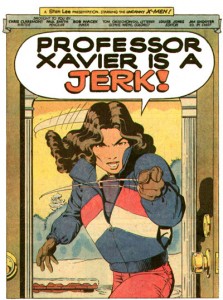Sunday Supervillainy on Thursday – “mutant women of Earth”
In the 1980s – well, actually from the second half of the ’70s through to the beginnings of the ’90s – Chris Claremont’s version of the X-Men was a dominant force in superhero comics. Whereas fans of other classic comics franchises may look back to earlier eras (often the 1960s in the case of Marvel, where the original runs of Fantastic Four and Spider-Man still stand up today), the “1980s” set the standard for X-Men.
Supervillainy has been a bit slow around here, so I missed my regular Sunday Supervillainy feature last weekend, but today I came across this wonderful post by Andrew Wheeler, written in praise of Claremont’s original X-Men run, and especially his use of female characters. It also comes with a thoughtful and well-developed thread, including some interesting debate about the representation of women in comics during Claremont’s run and now. In this regard, did Claremont really set a gold standard? Do modern creators do better? If not, should they? How?
Part of the problem, of  course, is that there is something inherently silly about all superhero comics if you push the analysis too hard. You really need to buy into a lot of conventions and assumptions to get much out of them, or else the handling of both male and female characters can quickly seem ridiculous. The problem is not just the scientifically implausible powers of the characters or their outlandish costumes. It also includes the extreme use of soap opera elements. Again, recurrent tropes such as mind control, moral reformations (and backslidings), bizarre technologies, crazy governments and populaces, and all the rest can create a mess over time. So, I’m not sure that anyone can easily say that the female characters in particular are used outlandishly in 1980s X-Men.
course, is that there is something inherently silly about all superhero comics if you push the analysis too hard. You really need to buy into a lot of conventions and assumptions to get much out of them, or else the handling of both male and female characters can quickly seem ridiculous. The problem is not just the scientifically implausible powers of the characters or their outlandish costumes. It also includes the extreme use of soap opera elements. Again, recurrent tropes such as mind control, moral reformations (and backslidings), bizarre technologies, crazy governments and populaces, and all the rest can create a mess over time. So, I’m not sure that anyone can easily say that the female characters in particular are used outlandishly in 1980s X-Men.
We can, of course, ask whether the female characters in a superhero story are depicted with the same prominence and complexity as the male characters (as opposed to how we might like to see either presented in a realistic movie or prose narrative). By and large, Claremont’s classic run still appears to me to stand up well in that regard. Characters like Storm, Kitty Pryde (pictured), Rogue, Psylocke, Jean Grey, Rachel Grey… and arch-villainess Emma Frost… flourished under his pen. Sure, they were often used partly as eye candy, but they were striking characters with unique personalities, diverse motivations, and impressive power sets that they employed effectively in combat. Speaking for myself, I loved these characters, maintained my interest in their problems, and enjoyed their exploits. Were some individual storylines weak? No doubt. But overall this was strong writing of its kind, and it centred very much on the so-called Claremazons.
It didn’t hurt that Claremont did great character work with Wolverine, whom he turned into one of the most popular comics characters of all, and from time to time with Magneto, who was transformed from a one-dimensional Dr. Doom knock-off into a truly major character with scary power levels and complex motivations of his own. Nonetheless, Storm and the other important female characters were central. If nothing else, Claremont demonstrated that comics fans will buy books with prominent female characters, at least in a team context.
The tropes and limitations of the genre may make it difficult to improve on Claremont’s work without quite radical transformations. As I hinted above, for everything ridiculous or over the top about his treatment of female characters we could probably find something corresponding with male characters. Commenters may be able to think of ways the industry could have moved forward, but I’m more concerned that it has gone backwards.
Perhaps the kick-ass presentation of the Black Widow in the recent Avengers movie will help with this. It was much praised, and not only by me, and it may show (as Claremont did) that fans appreciate female superheroes who are every bit at home in the same extraordinary situations as their male counterparts. I’m hoping that we see more of this, perhaps with new female characters (Carol Danvers, anybody?) in future movies. Meanwhile, as Wheeler’s article notes, back in the X-Men comics we’re going to see a new book with an all-star, all-female regular cast: Kitty Pryde, Psylocke, Rachel Grey, Rogue, and Storm. I hope the creators can achieve a touch of Claremont’s magic.


